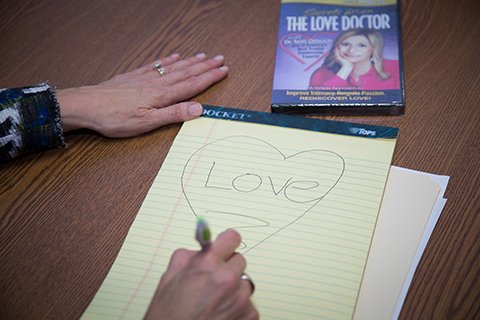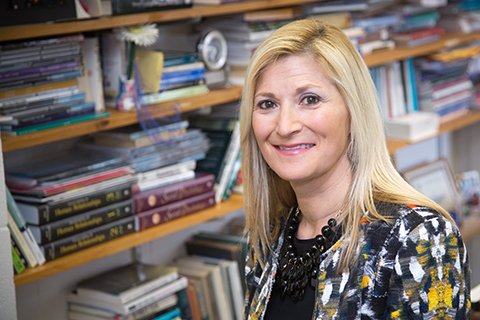- Department of Sociology, Anthropology, Social Work and Criminal Justice
- Sociology
- Anthropology
- Social Work
- Criminal Justice
- Applied Geographic Information Science
- Minors, Concentrations & Combined Programs
- Faculty Publications and Honors
- Departmental Advising
- Scholarships and Awards
- Student and Faculty Awards
- Student Clubs
- Support our Programs
- Community Engagement
- Faculty and Staff
- Events
Unique study follows couples nearly three decades

Social psychologist Terri Orbuch, Ph.D., has researched the same 373 married couples for nearly 30 years. The couples — 199 black Americans and 174 white Americans — were married in 1986 in Wayne County, Michigan.
They are part of the Early Years of Marriage (EYM) project funded by the National Institutes of Health. EYM is the only U.S. study to follow the same group of married couples for almost three decades.
Dr. Orbuch, a Sociology professor at Oakland University, has examined marriage’s external stressors such as money and in-laws, as well as internal relationship factors such as sexuality, conflict and communication.
Couples were interviewed together and separately. When these couples are compared to national married couples using Census data, she says, “these couples look similar to married couples across the country.”
Emerging from the EYM project is a sociodemographic portrait of marriage that considers factors that differentiate couples, revealing “what makes couples compatible, how happy couples stay resilient in the face of extreme challenges, and which specific behaviors erode happiness over time and inevitably lead to divorce,” Dr. Orbuch says.
 More than 100 articles, conference presentations and books have been created from the research, including insight into emotional ties to family, who will divorce, and the effects of marital boredom on future satisfaction in the marriage. In addition to adding to the body of knowledge about marriage, practitioners can share new insights gleaned from the EYM project with couples who seek premarital and marital education and counseling.
More than 100 articles, conference presentations and books have been created from the research, including insight into emotional ties to family, who will divorce, and the effects of marital boredom on future satisfaction in the marriage. In addition to adding to the body of knowledge about marriage, practitioners can share new insights gleaned from the EYM project with couples who seek premarital and marital education and counseling.
For example, a couple’s relationship with in-laws early in a marriage can affect whether they might divorce later. Dr. Orbuch studied early family ties and marital stability over 16 years in the context of race and gender. The study revealed that black couples were more likely to form stronger ties with in-laws, visit family more, and argue less about family matters than white couples. These close bonds, considered critical to happiness, equated in the study with less likelihood to divorce for the black couples over time.
“The study’s results highlight the need to explore in-law ties prior to and after couples make the transition to marriage,” Dr. Orbuch says. “Premarital counselors and educators can draw on these findings when discussing challenges that couples may face in the early years of marriage as they negotiate their family-of-origin relationships.”
As divorce rates skyrocketed in America, the literature had generally given greater attention to the structural (oppressive social conditions, lower status positions in society) rather than the interpersonal (i.e., burdens of parenthood) factors as explanations for divorce and low marital quality.
Analyzing 14 years of data from the EYM couples, Dr. Orbuch and her colleagues found that in addition interpersonal factors, race and education played strong roles in predicting divorce over time.
“We found that only for black couples did the husband’s participation in household tasks reduce the risk of divorce,”
Dr. Orbuch says. “This phenomenon was true for black couples, whether the assessment of participation was from the wife’s or the husband’s viewpoint. Moreover, there was a slight trend for an increased risk for divorce in white couples when husbands reported especially high participation in household tasks.”
The study found that the more education the wife had, the less likely the couple was to divorce. “We found that the odds of divorce decrease by a factor of .76 for each additional year of wives’ schooling,” Dr. Orbuch says. “This protective factor was true regardless of race. However, the effect of the husband’s education was conditioned by race.”
Satisfaction over the long term of a relationship can also be influenced by simple boredom, according to Dr. Orbuch’s research. In her 2009 study “Marital Boredom Now Predicts Less Satisfaction 9 Years Later,” Dr. Orbuch found that greater boredom in the seventh year of marriage predicted significantly less satisfaction at the sixteenth year, even after controlling for satisfaction in year seven. “However, greater satisfaction in year seven did not significantly predict less boredom in Year 16,” she says.
Dr. Orbuch says that short-term experiments demonstrate that couples can reduce boredom by doing exciting activities together. “The findings suggest that benefits may be substantial and long lasting for both husbands and wives and across racial groups.”
Other findings from Dr. Orbuch’s research, from her book 5 Simple Steps to Take Your Marriage from Good to Great:
- Couples whose parents divorced are just as happy as those whose parents stayed married.
- Couples are less likely to divorce when wives attend religious services and activities often.
- Courtship stories that continue to be romantic and full of emotion over the years predict of unhappiness for wives. Clear, detailed and well-crafted stories of the wedding and honeymoon over the years are also predictive of unhappiness for wives. Happier wives maintain overall positive affect about the wedding and honeymoon, but they tend to have lost the details.
- Being interdependent or intertwined (socially, emotionally and financially) is more critical to the happiness of white couples than black couples.
